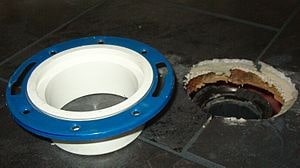Everybody has got their own unique idea on the subject of Toilet Flange Repair.

Introduction:
Comprehending the Importance of a Toilet Flange:
In the realm of plumbing, the often-overlooked toilet flange plays a crucial function in guaranteeing the smooth procedure of your bathroom fixtures. Acting as an essential connector in between your bathroom and the underlying drain, the bathroom flange functions as the unhonored hero of your plumbing system. Without this strong part, your bathroom would certainly be prone to instability and leaks, possibly leading to expensive repair services and hassle. As a result, understanding the value of a correctly set up and maintained toilet flange is vital for any kind of home owner embarking on plumbing tasks or resolving repair work requirements.
Why Proper Installation and Maintenance Matter:
Correct installment and careful maintenance of the toilet flange are important for securing the honesty of your plumbing framework. A meticulously set up flange not only anchors your commode securely in place yet additionally forms a bulletproof seal, warding off the dangers of leakages and smells. By embracing a positive strategy to flange upkeep, you can alleviate the risk of turbulent plumbing concerns and maintain the tranquillity of your house atmosphere. Throughout this informative guide, we'll unravel the ins and outs of bathroom flange installation and repair, empowering you with the knowledge and proficiency to navigate these necessary jobs expertly.
Ideal Practices When Installing a Toilet Flange:
Making sure a smooth bathroom flange installation requires adherence to a collection of ideal methods that ensure longevity and capability. Begin by meticulously evaluating your tools and products, guaranteeing you have the needed devices for the work ahead. Selecting the proper flange material, whether PVC, ABS, or cast iron, is vital, as it figures out the longevity and efficiency of your plumbing component. Additionally, assessing existing plumbing problems, such as looking for damage or rust, is essential for preemptively addressing possible complications and making certain a smooth installment procedure. By adopting these primary actions, you set a strong structure for an effective bathroom flange installation, reducing the chance of future concerns and facilitating lasting maintenance.
When effectively ready, proceed with the mindful removal of the old flange, following an organized approach to stay clear of creating damage to surrounding elements. Utilize techniques customized to address persistent or rusted flanges, ensuring their swift and risk-free elimination without jeopardizing the honesty of the bordering plumbing facilities. With the old flange eliminated, meticulously install the new replacement flange, choosing one that fits well and securely right into location. Properly securing the flange to the floor using screws or adhesive is vital, as it makes sure security and stops future leakages. By sticking to these finest practices during the installation procedure, you prepared for a durable and dependable commode flange configuration that stands up to the examination of time.
Setting Up a New Toilet Flange:
When mounting a brand-new toilet flange, the first step is to select the ideal replacement for your plumbing configuration. Consider aspects such as the material of the flange, with alternatives consisting of PVC, ABS, or cast iron. PVC flanges are known for their price and resistance to deterioration, making them a preferred choice for DIY fanatics. ABS flanges use comparable advantages to PVC yet brag added longevity, making them appropriate for high-traffic areas or business settings. Cast iron flanges, renowned for their stamina and long life, are suitable for setups where toughness is extremely important. In addition, make sure that the replacement flange is appropriately sized and fits comfortably right into location to produce a watertight seal and avoid leaks.
Protecting the Flange to the Floor:
When you've picked the right replacement flange, it's important to secure it properly to the floor to make certain stability and protect against future issues. Begin by positioning and lining up the flange properly over the drain, ensuring that it rests flush with the floor surface. Depending on the kind of flange and your details setup choices, you can protect the flange to the flooring utilizing screws or sticky. If making use of screws, make sure to utilize corrosion-resistant choices to avoid rusting gradually. Conversely, adhesive can provide a secure bond between the flange and the floor, making certain a sturdy and trustworthy installment. By complying with these actions and taking the required preventative measures, you can set up a new bathroom flange with confidence, ensuring a long-lasting and leak-free plumbing fixture.
Ideal Practices When Repairing a Broken Flange:
Repairing a broken toilet flange demands careful interest to detail and adherence to ideal methods to make sure a lasting remedy. Begin by completely evaluating the level of the damage and identifying the underlying reason, whether it be corrosion, cracks, or imbalance. This assessment will certainly assist your repair work method, permitting you to pick one of the most suitable strategies and materials for bring back the flange to its optimal problem. Additionally, consider the surrounding plumbing infrastructure and floor stability to attend to any kind of prospective contributing factors and protect against future issues from arising. By conducting a detailed evaluation and analysis, you lay the groundwork for a reliable and enduring repair work procedure that fixes the source of the trouble.
With a clear understanding of the flange's problem and the variables influencing its damage, wage the repair service procedure using accuracy and treatment. Depending upon the severity of the damages, you may go with repair service techniques such as epoxy putty, fixing flange sets, or partial flange substitutes. Make sure that the chosen fixing method successfully resolves the specific problems available while keeping the structural stability and capability of the flange. In addition, take proactive actions to enhance the fixed flange and stop future damage, such as applying sealant or waterproofing products to safeguard against leaks and corrosion. By adhering to these best practices throughout the repair service procedure, you can restore your damaged flange to ideal problem, guaranteeing the long-lasting dependability and performance of your plumbing system.
Types of Toilet Flanges:
Comprehending the different kinds of toilet flanges is essential for picking one of the most appropriate alternative for your plumbing requires. PVC, ABS, and cast iron are among the common products used in toilet flange building and construction, each offering unique advantages and factors to consider. PVC flanges, recognized for their cost and deterioration resistance, are favoured for their convenience of installment and durability. Abdominal muscle flanges, comparable to PVC in regards to price and ease of setup, are valued for their effectiveness and resistance to effects. On the other hand, cast iron flanges, renowned for their extraordinary strength and long life, are typically liked for high-traffic areas or industrial settings where longevity is critical. By familiarising on your own with the characteristics of each material, you can make an informed decision when choosing a commode flange that aligns with your certain needs and choices.
Along with material considerations, toilet flanges also are available in various styles and designs to fit various plumbing configurations and installation choices. Offset flanges, for instance, are created to accommodate commodes set up on floorings that are uneven or where the drain is located off-centre. Likewise, repair work flanges, likewise referred to as repair rings or spacer rings, are utilized to attend to issues such as broken or damaged flanges without the requirement for comprehensive plumbing modifications. Additionally, adjustable flanges use adaptability ready, allowing for specific placement and fit throughout installation. By exploring the diverse range of toilet flange types and layouts offered, you can choose the choice that ideal suits your plumbing configuration and installment needs, guaranteeing a smooth and reputable remedy for your bathroom fixtures.
Specialty Options:
In addition to standard commode flanges, there are specialized alternatives available to deal with certain plumbing obstacles and installation preferences. One such choice is the balanced out flange, which is developed to accommodate bathrooms mounted on floorings that are uneven or where the waste pipe is located off-centre. Countered flanges feature an unique layout that permits the bathroom to be positioned at a slight angle, making up for unequal flooring or misaligned plumbing connections. This innovative remedy guarantees a safe and secure and stable installation, eliminating the requirement for pricey and lengthy flooring leveling or pipeline moving. By including an offset flange right into your plumbing configuration, you can get over usual setup barriers and attain a professional-quality result effortlessly.
One more specialized option worth considering is the repair service flange, likewise known as a repair work ring or spacer ring. Repair flanges are especially created to address issues such as fractured or damaged bathroom flanges without the requirement for substantial plumbing modifications. These versatile elements can be mounted directly over the existing flange, supplying a tough and dependable base for safeguarding the commode in position. Repair flanges can be found in various sizes and configurations to accommodate various flange sizes and installment needs, making them a hassle-free and cost-efficient solution for resolving flange-related problems. Whether you're dealing with a small flange repair service or a much more complex plumbing concern, including specialty alternatives like balanced out and repair work flanges can streamline the installment process and make certain lasting efficiency for your restroom components.
Conclusion:
Finally, understanding the art of bathroom flange setup and repair is essential for preserving a practical and leak-free plumbing system in your house. By recognizing the importance of an appropriately set up flange and adhering to finest practices throughout the process, you can make certain the longevity and dependability of your washroom components. Whether you're selecting the best sort of flange, performing repairs, or checking out specialty options, interest to information and precise execution are key. Routine upkeep and positive repairing can help stop pricey plumbing issues and maintain the tranquility of your house atmosphere. Armed with the expertise and abilities acquired from this thorough guide, you can take on bathroom flange installment and fixing with confidence, empowering you to secure your plumbing system for several years to come.
How to Install a Toilet Flange on A Concrete Floor
Preparation in Installing or Replacing a Toilet Flange
Gloves Screwdriver Hacksaw or a power saw Measuring tape Putty knife Hammer New screws (if needed) New T-bolts (if needed) New wax ring (if needed) Remove the Old Flange
The first step is to remove the old flange. You can unscrew the bolts that hold the flange in place. If the bolts are rusted or stuck, you may need a grinder to get them out.
Once the bolts are out, you should be able to pull the flange out if needed. You can try prying it out with a screwdriver or a putty knife if it’s stuck.
Scrape off the Old Wax Ring
Now that the flange is out, you need to remove the old wax ring. You can do this by scraping it off with a putty knife. Be sure to get all of the wax off so that the new wax ring will adhere properly.
Clean the Area around the Drain
Once the wax ring is removed, you need to clean the area around the drain. This will ensure that the new flange is attached appropriately.
You can use a brush and some soapy water to clean the area. If there is any rust or build-up, you may need to use a power drill with a wire brush attachment to remove it.
Measure the Size of the Flange
Now that the area is clean, you need to measure the size of the flange. This will ensure that you get the correct size flange for your toilet.
Most flanges are either 3 or 4 inches in diameter. To measure the diameter, you will need to use a tape measure.
Select the Correct Size Flange
Once you know the diameter of the flange, you need to select the correct size. If you’re not sure which size to get, you can always ask a salesperson at the hardware store for help.
One way to ensure that you get the right size flange is to take the old one to the store. Just make sure that the old flange is clean and free of any wax or build-up.
Set the Toilet Flange in Place
The next step is to set the new flange in place. You will need to align the flange with the drain to line up the bolt holes. It would help if you also considered the distance from the wall.
Most flanges are designed to be installed about 12 inches from the wall to the center of the flange. However, you may need to adjust this based on the size of your toilet. Our favorite flanges to install are twist in flanges which you can pick up from your local Home Depot. You can check them out here.
Drill Holes for the Screws
Once the flange is in place, you need to drill holes for the screws in the concrete. You will need to use a concrete drill bit that is slightly smaller than the screws.
The number of screws you need will depend on the size of the flange. Most flanges require four screws to hold them in place.
Install the Screws
Once the holes are drilled, you can install the screws. You will need to use a screwdriver to tighten them in place. Be sure not to overtighten the screws as this can damage the flange and may cause the toilet to leak from the base.
Place the New Wax Ring on the Flange
Now that the flange is installed, you need to place the wax ring on top. The ring should fit snugly around the flange.
If you’re not sure which size wax ring to get, you can always ask a salesperson at the hardware store for help.
Set the Toilet Bowl in Place
Now that the wax ring is in place, you can set the toilet bowl in place. You will need to align the bolt holes with the holes on the flange. Once the bowl is in place, you can start to tighten the bolts.
Connect the Water Supply Line
The final step is to connect the water supply line to the toilet. You will need to screw the line into the fitting on the bottom of the tank.
Once the line is tight, you can turn on the water supply and flush the toilet to check for leaks. If there are no leaks, then you’re done! You’ve successfully installed a toilet flange.
If you want to know more about the entire toilet installation process, from removing to installing a new toilet, you can check out our article about How to Remove a Toilet and Replace It With a New One.
Conclusion
Installing a toilet flange is a relatively easy do-it-yourself project. Just be sure to measure the flange and select the correct size. Also, you should remember is that the screws must be hand tight only; overtightening them may cause the flange to break.
However, if you have doubts about your plumbing skills, it’s always best to call a professional plumber to help you install your toilet flange or even your entire toilet. This can save you time, money, and headaches because they know how to do it quickly and efficiently.
If you live in Lower Mainland copyright and need a trustworthy and experienced plumber to install your toilet flange, Your Guy Plumbing is here to assist you 24/7. We offer toilet installation and repair, as well as other plumbing services to meet all of your needs.

We had been brought to that editorial about Toilet Flange Repair from an associate on a different web blog. Sharing is nice. One never knows, you may be helping someone out. Thank you so much for taking the time to read it.
Top Article
 Luke Perry Then & Now!
Luke Perry Then & Now! Kelly McGillis Then & Now!
Kelly McGillis Then & Now! Mason Gamble Then & Now!
Mason Gamble Then & Now! Andrew McCarthy Then & Now!
Andrew McCarthy Then & Now! Ricky Schroder Then & Now!
Ricky Schroder Then & Now!